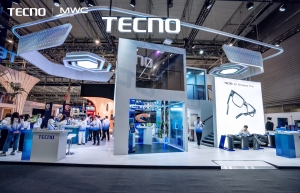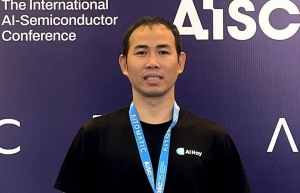AI Hay and important strides to build advanced AI models in Vietnam
09:00 | 14/04/2025 Print Article
AI is transforming sectors globally, bringing new opportunities. Hiep Nguyen, COO of AI Hay, spoke to VIR’s Bich Thuy about his company’s vision to pioneer the latest technology, contributing to making Vietnam a regional AI innovation centre.
How are the latest AI trends impacting the Vietnamese market?
 |
| Hiep Nguyen, COO of AI Hay. Photo: AI Hay |
AI is undeniably transforming industries worldwide, redefining how businesses operate and how we engage with technology. At NVIDIA's GPU Technology Conference (GTC) 2025, we saw several groundbreaking trends emerge, with physical AI and robotics standing out as a glimpse into the future.
Physical AI, fuelled by advanced computing, sophisticated reasoning models, and NVIDIA’s cutting-edge chips, is accelerating the evolution of robotics. This is not just about factory automation any more, it is a signal that robots will soon permeate every sector, such as healthcare, agriculture, logistics, and even our homes.
That said, before robotics fully takes hold, two more immediate and foundational trends are driving the AI landscape: AI factories and the token economy. AI factories represent a new breed of data centres, purpose-built to generate tokens – the core units of AI output like text, decisions, or simulations – at unprecedented scale and efficiency.
With innovations like NVIDIA’s Dynamo platform and a robust suite of hardware and software unveiled at GTC 2025, we are entering an era where token generation is faster and more cost-effective than ever. The token economy builds on this, reimagining tokens as a currency of AI value creation. The same way electricity powered the last era, tokens will power this era. It’s about optimising production to make AI not just powerful but accessible, whether that’s for smarter chatbots, predictive analytics, or the robotics we just mentioned. As NVIDIA’s Jensen Huang put it, 'The more you buy, the more you save', a nod to the economies of scale this approach unlocks.
For Vietnam, these trends present a remarkable opportunity. Our country is already riding a wave of momentum, with a strong and forward-looking government backing through its national AI strategy and incentives that nurture a vibrant startup ecosystem. Add NVIDIA’s recent decision to establish an research and development centre here, and Vietnam has a front-row seat to the AI revolution. We believe this could spark significant economic growth, create high-value jobs, and position Vietnam as a hub for innovation.
How do you evaluate the application of AI and generative AI in Vietnam?
Vietnam's AI market is growing fast. In 2023, it was valued at approximately $554 million and is expected to hit $932 million this year. This growth is being driven by the digital transformation across different industries and the government’s strong support for AI development.
However, what’s even more exciting is how quickly GenAI is being adopted by Vietnam's younger generation, particularly those stepping into leadership roles. According to PwC’s NextGen Survey 2024, over 80 per cent of Vietnam’s next-gen leaders are excited about GenAI and its potential to revolutionise business operations. They see GenAI as a game changer, expecting benefits like improved employee productivity, cost savings, and better customer experiences. These leaders are not just eager to try out new tech, they are also focused on building solid digital foundations and upskilling their teams to make the most of AI.
At AI Hay, we see this generational shift as a crucial opportunity. Our mission is to make AI more accessible and practical to the Vietnamese market by developing models and products tailored to the Vietnamese language, culture, and business environment. By doing so, we can bridge the gap between advanced AI technology and real-world applications, empowering both enterprises and individuals in Vietnam.
Which is AI Hay doing to build advanced AI models that help systems become smarter and contribute to making Vietnam a regional AI innovation centre?
At AI Hay, our vision is to lead the charge in adopting and innovating with the latest AI technologies, helping establish Vietnam as a premier AI innovation hub in Southeast Asia. Central to this ambition is our commitment to democratising AI access for all 100 million Vietnamese people, spanning every age, occupation, and literacy level.
We’re building consumer AI products that are affordable, scalable, and designed to deliver safe, expansive knowledge to the masses. By breaking down barriers to technology, we aim to uplift Vietnam, narrowing societal divides and cultivating a more informed, interconnected nation that’s ready to thrive in the digital age.
 |
| Hiep Nguyen and the NVIDIA APAC team at GTC 2025. Photo: AI Hay |
Our approach is deeply rooted in tailoring AI to Vietnam’s unique context, focusing on NLP layering and post-training optimised for the Vietnamese language, culture, and business landscape. This ensures our AI is not just accessible, but resonates meaningfully with local communities. To do so, we focus on three key pillars.
Firstly, at the heart of AI Hay’s innovation is a model-agnostic system architecture that does not rely on a single large language model (LLM). Instead, it dynamically orchestrates responses across a combination of open-source and closed foundational models. Unique to AI Hay is HayLM, a specialised Vietnamese-language model optimised for cultural and linguistic understanding.
The system first rewrites the query based on its NLP layer, and intelligently routes each query automatically selecting the best-fit model, without requiring users to make that decision themselves. This orchestration marks a major advancement in fully automated AI experiences, taking the guesswork out of using AI, and making sure we focus on what matters: bringing the best experience to users.
Secondly, AI Hay integrates advanced retrieval capabilities via ProSearch, a proprietary search system that decomposes queries and conducts searches across both internal data and external platforms (like Google and social media) across many language sources. The system ranks and summarises this information before passing it to the LLMs, resulting in more accurate, current, and context-aware answers. This blend of retrieval-augmented generation and deep model reasoning is key to building systems that are not just responsive, but meaningfully smart, extending beyond “existing” search outputs Vietnamese usually see.
Lastly, beyond answering questions, AI Hay actively enhances user engagement and learning through a contextual recommendation engine. It suggests follow-up questions related to the user’s current query and offers personalised content via the “For You” and “Notifications” tabs. This continuous-loop feedback system helps the model refine relevance and deepen user interaction, an essential step towards building truly intelligent, adaptive AI systems.
Together, these innovations position AI Hay at the frontier of intelligent system design, merging deep language understanding, real-time knowledge integration, and personalised interaction in a way that sets a new bar for AI products in Vietnam and beyond.
 | Demand for Industry-specific AI drives increasing adoption of IFS.ai 60+ in-depth IFS.ai scenarios available now in IFS Cloud 24R2 |
 | Fotor Launches Generative AI Presentation Maker: Fotor AI Slides That You Need Fotor, a global leader in AI-powered photo editing and graphic design platforms, has launched its latest innovation, Fotor AI Slides. |
 | Create the AI Future: TECNO Unveils Next-Gen AI Ecosystem at MWC Barcelona 2025 Innovative AI-driven technology brand TECNO is excited to announce its participation at MWC Barcelona 2025, March 3-6 , showcasing how it is unlocking the potential of AI technologies. |
 | Technology startups must deliver coherent value Being a startup is a risky endeavour, fraught with numerous challenges and unpredictability, and tech startups also face obstacles in accessing core technologies. Nguyen Tho Chuong, chief technology officer at AI Hay, told VIR’s Hai Nam about the challenges in approaching key technology. |
Bich Thuy
Post path: https://vir.com.vn/ai-hay-and-important-strides-to-build-advanced-ai-models-in-vietnam-126242.html
